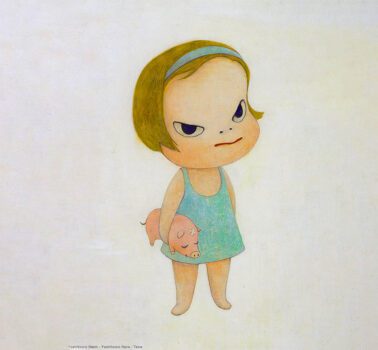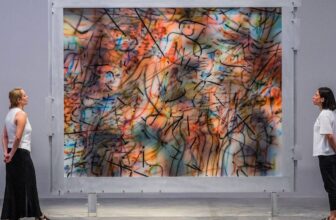What Is Yoshitomo Nara Known For
Yoshitomo Nara is one of the most recognized names in contemporary Japanese art, a figure who has captivated audiences across the world with his deceptively simple yet emotionally resonant works. With wide-eyed children, subtle rebellion, and layered emotions, Nara’s work stands at the crossroads of pop culture, personal memory, and artistic sophistication. His art is both accessible and profound, charming and unsettling, qualities that have made him a global icon and his pieces highly coveted in the international art market.
This post delves deep into Yoshitomo Nara’s unique artistic universe, exploring how much his artwork costs, what he’s known for, his most famous pieces, techniques, materials, and where his art can be found today. Through this, we’ll trace the journey of a man whose seemingly innocent children with piercing gazes have redefined how contemporary society sees childhood, rebellion, and vulnerability.
Who is Yoshitomo Nara?
Yoshitomo Nara (born December 5, 1959, in Hirosaki, Aomori Prefecture, Japan) is a contemporary visual artist known for his paintings, drawings, and sculptures of children and animals that blend innocence with subtle defiance. Although his artwork often appears simplistic at first glance, owing to his use of cartoonish styles and pastel colors, it communicates deeply layered emotions such as loneliness, frustration, nostalgia, and even quiet rage.
Nara studied at the Aichi Prefectural University of Fine Arts and Music and later earned a Master’s degree from the Kunstakademie Düsseldorf in Germany during the 1990s. His time in Germany had a lasting impact on his work, allowing him to blend Western and Eastern artistic traditions in a way that feels wholly unique.
Yoshitomo Nara is best known for his iconic depictions of wide-eyed children and small animals with unsettling or rebellious expressions. These figures often carry objects like knives, cigarettes, or banners, symbolic representations that juxtapose childlike innocence with a deeper emotional or social commentary.
Nara’s work is frequently interpreted as a reflection of his own childhood memories and feelings of isolation, particularly growing up as a “latchkey kid” in post-war Japan. His art is not overtly political, but it often contains a quiet protest against authority, conformity, and societal pressure. This nuanced messaging, paired with his accessible visual style, allows his work to speak to a wide audience across generations and cultures.
What Art Style Is Yoshitomo Nara Associated With?
Nara’s work is typically associated with Neo-Pop, a postmodern art movement influenced by pop culture, cartoons, and mass media. He is also linked to Superflat, a term coined by fellow Japanese artist Takashi Murakami, which refers to a visual style that flattens distinctions between high and low art, and often references anime, manga, and commercial design.
However, Nara’s work is more introspective and emotionally complex than many of his Neo-Pop peers. Unlike Murakami’s polished, mass-produced aesthetic, Nara embraces imperfection. His lines are hand-drawn, his brushwork is often rough or childlike, and he resists digital techniques. This adds a tangible intimacy to his works that often feels autobiographical.
How Does Yoshitomo Nara Make His Artwork?
Yoshitomo Nara creates his art through a multi-faceted and deeply personal process that often begins with drawing. His studio is filled with hundreds of sketchbooks where he spontaneously jots down ideas, doodles figures, and captures emotional expressions. These sketches sometimes evolve into larger paintings, sculptures, or installations.
Nara is known for using traditional materials such as acrylic on canvas, but he also explores mediums like wood, bronze, paper, and mixed media. His paintings often involve layering and texturing that provide depth, both physically and emotionally. He prefers to build his imagery organically, allowing each piece to evolve over time rather than working from detailed plans.
In his sculptures, Nara often carves wood or molds fiberglass to create three-dimensional versions of his characters. These sculptures, like his paintings, often carry the same emotive expressions that range from melancholy to mischievous.
He once described his art-making process as “spending time with his drawings” until they begin to “speak back” to him. This poetic approach reveals the degree to which he connects with his characters, not as objects but as living extensions of his emotional landscape.
What Materials Does Yoshitomo Nara Use?
Over the years, Yoshitomo Nara has employed a wide variety of materials, often combining traditional techniques with contemporary expressions:
Acrylic on canvas – His most recognizable works are painted with fast-drying acrylics, which help him maintain spontaneity in his brushwork.
Wood – For sculptures and installations, Nara often carves from wood, particularly in his recent works which have a more rustic and tactile feel.
Fiberglass and resin – Used for more durable and larger sculptural pieces.
Paper – His sketches, watercolors, and drawings on paper are an essential part of his creative practice.
Found objects – He occasionally uses found materials, such as old doors, crates, or windows, which add narrative and texture to his work.
This diversity of materials allows Nara to blur the line between fine art and craft, creating a world where each piece feels handmade and intimate.
What Is Yoshitomo Nara’s Famous Artwork?
Among his vast portfolio, several iconic works stand out:
“Knife Behind Back” (2000)
Perhaps his most famous painting, it features a small girl with a devilish smirk holding a knife behind her back. The work sold for over $24 million in 2019, setting an auction record for the artist.“Too Young to Die” (2002)
Featuring a cigarette-smoking child alongside a skull and crossbones, this painting plays with punk rock motifs and existential themes.“Midnight Vampire” (2011)
A sculpture featuring a child-like figure with vampire teeth, tapping into themes of duality, fear, and play.“Fountain of Life” (2001–2014)
A large bronze fountain sculpture featuring heads of his iconic children, symbolizing interconnectedness and perhaps a cycle of emotion and memory.“In the Milky Lake” (2012)
A quiet, contemplative painting showing a girl submerged in water, her face serene and ambiguous.
Each of these works showcases Nara’s trademark blend of childlike imagery with mature emotional undercurrents, and they continue to captivate audiences around the globe.
How Much Does Yoshitomo Nara’s Artwork Cost?
The cost of Yoshitomo Nara’s artwork can vary dramatically depending on the medium, size, and rarity. Here is a general breakdown:
Drawings and works on paper: $10,000 – $500,000
Smaller sketches and original drawings are more accessible but still highly collectible.Paintings: $100,000 – $25 million+
His larger acrylic-on-canvas works command the highest prices. For example, “Knife Behind Back” sold for HK$195.6 million (~$24.9 million) at Sotheby’s Hong Kong in 2019.Sculptures: $100,000 – $3 million+
Depending on scale and materials, his 3D works can fetch significant sums.Prints: $1,000 – $25,000
Limited edition lithographs and silkscreens are available at a more accessible price point, though rare prints also attract high bids.
Collectors view Nara’s work not just as aesthetically pleasing but also as sound investments, which has pushed auction prices to record highs in recent years.
How Many Artworks Does Yoshitomo Nara Have?
While it is difficult to determine an exact number, Yoshitomo Nara has produced thousands of works over his four-decade-long career. His practice includes:
Hundreds of paintings
Thousands of drawings and sketches
Numerous sculptures
Several large-scale installations and collaborations
He is also prolific in his exhibition participation, having shown in more than 200 solo and group exhibitions around the world. The sheer volume of his work is a testament to his dedication and the deeply personal nature of his art-making process.
Where Can You See Yoshitomo Nara’s Artwork?
Yoshitomo Nara’s work is featured in prestigious museums, galleries, and public spaces across the globe. Some key locations include:
Japan
Aomori Museum of Art, Aomori – Home to several permanent installations, including large-scale sculptures.
Yoshitomo Nara Studio, Nasushiobara – Though not open to the public, it’s the heart of his creative practice.
Hara Museum of Contemporary Art, Tokyo – Frequently showcases his works.
United States
Los Angeles County Museum of Art (LACMA)
Museum of Modern Art (MoMA), New York
San Francisco Museum of Modern Art (SFMOMA)
Europe
Pinakothek der Moderne, Munich, Germany – A nod to his time in Düsseldorf.
Centre Pompidou, Paris – Occasionally features his work in rotating exhibitions.
Asia and Beyond
Taipei Fine Arts Museum
K11 Musea, Hong Kong
National Gallery Singapore
In addition to museum holdings, Nara’s art frequently appears in traveling retrospectives and special exhibitions, such as his 2021–2022 retrospective at LACMA, which drew record attendance.
Yoshitomo Nara’s art speaks softly but powerfully. With minimalistic lines and wide eyes, his figures invite viewers to confront their own emotional landscapes. Whether it’s a scowling child hiding a knife or a meditative girl floating in water, his characters are vessels of tenderness, trauma, and resistance.
The value of Nara’s artwork, both monetarily and emotionally, reflects the powerful connection his audience feels with his work. He has turned vulnerability into power, memory into vision, and childhood into a canvas of endless complexity.
In a world dominated by noise and spectacle, Nara offers something rare: quiet truth.




